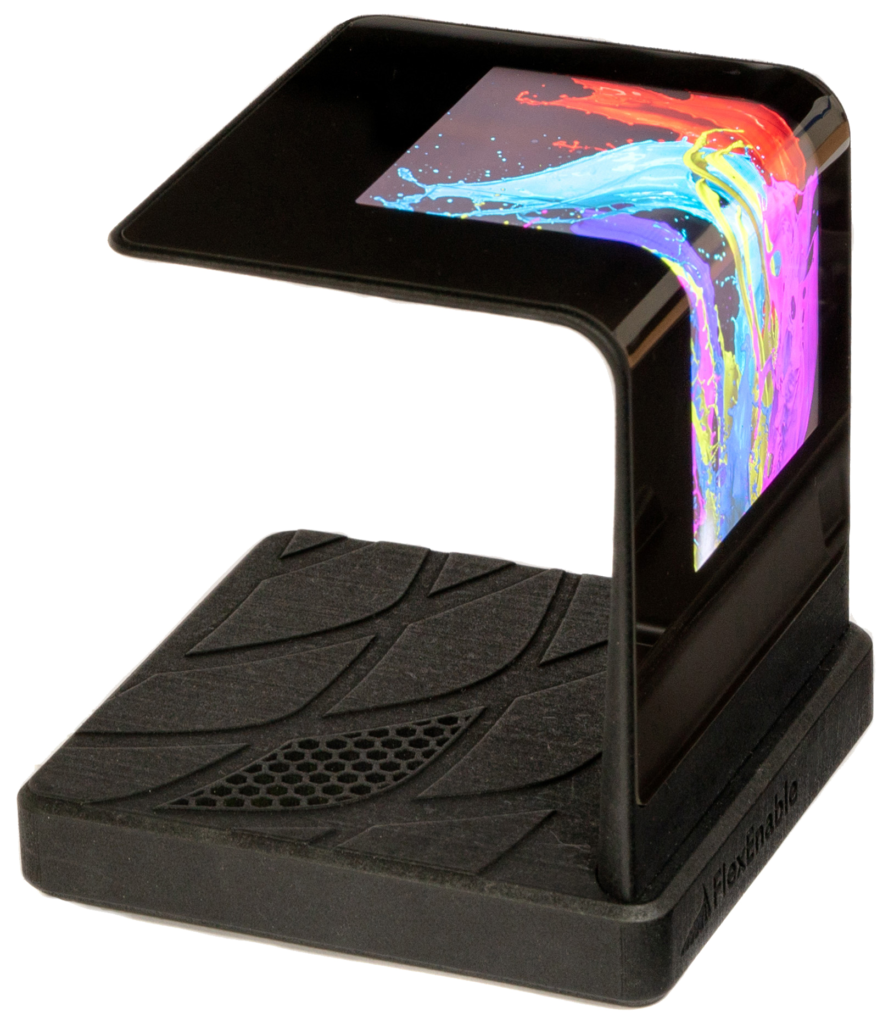Created in 2015 as a spin-off from Cambridge University, FlexEnable is now one the leading European company in the field of flexible display products.
Having developed the world’s first industrially-proven organic transistor technology platform, FlexEnable’s technology brings surfaces to life almost anywhere, by bringing flexibility and conformability to displays, sensors and optics. With the acquisition of the world-leading organic thin-film transistors (OTFT) materials from Merck – now branded as FlexiOM™ – FlexEnable acquired a fully developed and established product portfolio with applications for flexible displays and OTFT devices offering a complete package of an industrially-proven flexible electronics manufacturing technology and associated process-optimised materials. They accepted to share with us their vision of Organic & Flexible electronics’ future.
- From your perspective, how are flexible electronics a differentiator?
From a product point of view, flexible electronics is a technology that allows you to build electronic circuits on flexible substrates over large areas, making them bendable and conformable to surfaces. This enables striking new product paradigms that aren’t possible with conventional semiconductors and glass substrates. Flexible electronics are by nature flexible, lightweight, thin and shatterproof – they bring value to almost all existing display applications as well as unlocking many new use cases.
- What are the growth prospects for flexible electronics?
With regard to flexible displays, which is one of the key sectors FlexEnable is focused on, the market potential is huge. Today the global displays market is around $140Bn, comprising almost entirely of Liquid Crystal Display (LCD) and organic light-emitting diode (OLED) displays. For LCD the market is dominated by glass based, rigid displays. There is a growing demand for thin, lightweight and flexible displays that will unlock a new dimension in design freedom in existing products and open up completely new use cases. For flexible display applications that require larger area or longer lifetime with high brightness, it is now recognised that the attributes of FlexEnable’s flexible OLCD technology are needed. Flexible OLCDs are therefore forecast for major growth over the coming years for applications such as smart home devices, notebooks and tablets, automotive, TVs and monitors, and digital signage.
In addition to OLCD, there are many future applications for FlexEnable’s OTFT platform and materials, including ultra-thin and flexible biometric sensors, X-ray detectors and wearable/embeddable bio-sensors, allowing almost any surface to sense as well as display information.
- How is FlexEnable disrupting the market?
Our complete manufacturing solution for flexible displays is by far the lowest cost flexible display technology, and the reason for this is the very low manufacturing temperature for OTFT (below 100°C) which directly improves yield for flexible electronics, and allows the use of very low cost substrate materials such as TAC or PET. The technology is also specifically optimised to be implemented in existing flat panel display factories, minimising time and cost to mass production. Our OTFT technology is a flexible organic transistor which can drive flexible displays and sensors, and can be applied across curved and non-rectangular surfaces.
- What are Europe’s strengths in terms of flexible electronics and what role is FlexEnable playing in promoting these?
Europe has a strong position in terms of understanding of materials science, production process and device architectures for organic electronics, and FlexEnable is bringing these capabilities into volume manufacture in Asia.
Initially, we see traction for our flexible electronics technology in displays, consumer electronics, automotive, and digital signage, all of which are places where conformable displays can make a clear step change in device utility and application, and redefine our perception of how and where displays are used in our daily lives.
- What is next for FlexEnable and its technology?
We have active tech-transfer and licensing programs with displays companies using our proven OTFT materials. OLCD adoption is driven by the need to move away from flat screens towards novel display shapes and designs in order to improve aesthetics of existing products and enable new use cases. In parallel with transferring the technology to production, FlexEnable is partnered with leading OEMs and brands who want to use these displays in future products for applications in consumer electronics, automotive, notebooks, monitors and TVs.
We are so used to displays being made of glass that we forget what a huge constraint it presents to product design as well as limiting use cases. OLCD will allow new designs for existing products, and completely new use-cases are already emerging that were until now unthinkable with glass displays.

